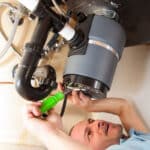Most Common Dishwasher Problems Can be Solved at Home
Dishwashers are one of the most time-saving appliances in the house because they can clean a large number of dishes in a relatively short amount of time. And because of improvements in technology, dishwashers are more efficient than ever, saving money on both water and energy usage. But when something goes wrong with your dishwasher, it can feel like a big mountain to climb to find out the problem and get it repaired. Don’t worry, it doesn’t have to be this way. Remember that safety should always be your top priority when attempting any repair. This means turning off the power to the appliance from the breaker box and using the proper tools for the job. The following is a list of the most common dishwasher problems and how to troubleshoot and make the repairs yourself.
1. Your Dishwasher Doesn’t Run
You have a load of dirty dishes ready to go, and when you turn the dishwasher on… Nothing. Don’t panic. There can be a number of reasons why the dishwasher doesn’t run.
Start with the basics.
First, see if any electricity is getting to the dishwasher. Are the lights on the control panel lit up? If not, then it’s obvious that no electricity is getting to the appliance. Now a little detective work is necessary.
If the dishwasher is plugged into a GFCI outlet, check to see if it tripped. If it has, then reset it. If it’s hardwired in, look at the other GFCI outlets in the kitchen to see if any of them have tripped. They might be on the same circuit as the dishwasher.
If nothing is out of the ordinary, then go to the breaker box and see if the circuit that provides power to the dishwasher has tripped or the fuse has blown. If it has, then reset the breaker or replace the fuse. If not, then your dishwasher might have a more serious problem, and it’s a good time to call in a professional.
2. The Dishwasher Is Not Filling Up With Water
Another of the most common dishwasher problems is when the dishwasher does not fill with water. Without water, a dishwasher is useless. If you’re turning your dishwasher on, but it’s not filling with water, there are two possible causes.
The first is that there could be a problem with the water supply. The second is that the water is draining too soon.
Your first task is to check to see if the hot water supply valve is turned on. You can find this under the kitchen sink. If you haven’t turned it off recently, then this is unlikely to be the culprit. But it never hurts to check anyway.
Assuming the hot water valve is on, it’s time to get your hands dirty. You’ll need to locate and inspect your dishwasher’s float assembly. This can be found in the base of the tub, usually near the front. After carefully lifting out the float assembly, inspect it to see if there are any obstructions that might prevent it from working properly. While you have it out, it’s a good idea to clean around the float tube just in case there is a lot of dirt and grease build-up. If the float assembly looks to be in good working order, then there’s another place you can check.
Before this next step, shut off the hot water valve under the kitchen sink. Remove the bottom front panel and locate the water intake valve. If you disassemble the valve you’ll find a screen. Clean any dirt and other debris that might have collected on the screen.
If the screen happens to be clean, then put everything back together again and call your local appliance repairman. The problem might be in one of the electronic components of the dishwasher and will need a professional to diagnose and repair.
3. Your Dishwasher Doesn’t Drain
One of the most common dishwasher problems is that the dishwasher doesn’t drain. This is a problem you want to take care of as soon as possible due to the risk of flooding.
First, check the drain hose. You should find it under the kitchen sink leading to the dishwasher. Check the hose to see if there are any blockages. If not, then shut the power off to the dishwasher and make sure it has cooled down. Remove the strainer (usually located under the spray arm) by unscrewing the hubcap and removing any clips keeping the strainer in place. Scrub and wash the strainer.
If your dishwasher still does not drain properly, call a plumber because there’s a clog somewhere in the drain line that might be tougher to fix.
If Unsure, Always Call A Professional
If your dishwasher is having any problem that you are uncomfortable troubleshooting and/or uncomfortable fixing, call in a professional. Trying to fix it yourself can end up costing more money if you do it wrong, or worse, break something else while performing the repair. Also, safety must always be a top priority. Call in a professional dishwasher repair technician to diagnose and repair your machine.




